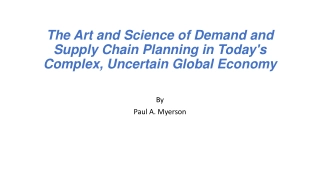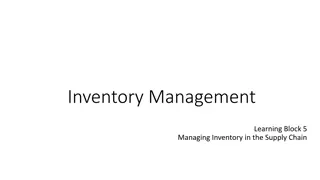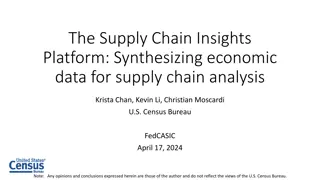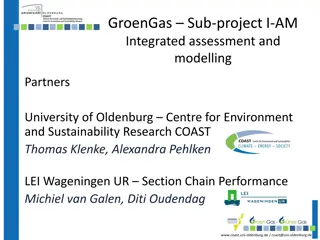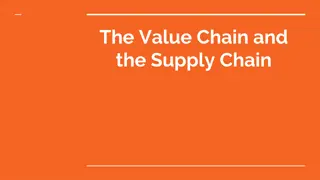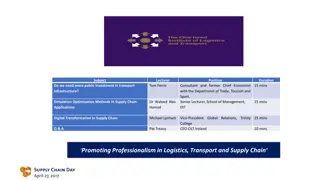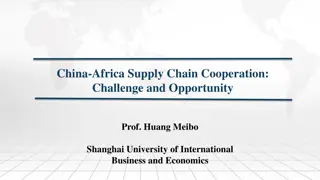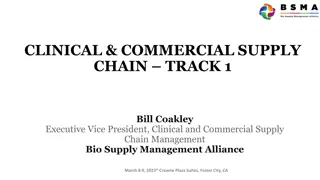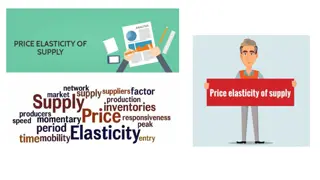Leveraging Supply Chain Capacity for Agility
Understanding the capabilities of companies in the WHIN region to identify supply chain configurations for producing products during short timeframes at minimum cost. Leveraging pockets of capacity within individual companies, exploring equipment, certifications, and aggregate capabilities to develop efficient solutions. Utilizing a capacity model outline to configure a combination of companies with slack machine capacity, aiming to reduce supply chain leakage and enhance responsiveness.
Download Presentation

Please find below an Image/Link to download the presentation.
The content on the website is provided AS IS for your information and personal use only. It may not be sold, licensed, or shared on other websites without obtaining consent from the author. Download presentation by click this link. If you encounter any issues during the download, it is possible that the publisher has removed the file from their server.
E N D
Presentation Transcript
Capacity Market Model and Agility Ananth. V Iyer Director, DCMME Susan Bulkeley Butler Chair in Operations Management aiyer@purdue.edu Funded by the Lilly Endowment through a grant Wabash Heartland Innovation Network (WHIN)
9/27/2019 Leveraging Supply Chain Capacity to gain Agility Individual companies may have pockets of capacity available during a specified period The capacity comes bundled with labor to deliver performance of specific customer-specified product transformations (e.g., drill a hole of a certain dimensions, finish etc at a specific location in a blank) Customers want jobs completed during short time windows, and may be willing to pay a premium But there may not be one company who can do all the steps, so the capacity is in the supply chain How do we identify possible supply chain configurations to produce products during short time windows at minimum cost ? 2
We first begin with understanding capabilities Gather data regarding capabilities of the 280 companies in the WHIN region Identify the equipment, certifications, tolerances, products made by all companies within the region Take stock of aggregate capabilities in the 10 counties comprising the WHIN region
Data regarding companies can also be accessed via Google maps Data Regarding companies can also be accessed via Google maps https://www.google.com/maps/d/u/0/edit?hl=en&mid=1wTuZYpUWibidPiNPUe8rycoJN4COUfLd&ll=40.5371668 8039053%2C-87.73263441406255&z=9 4
11/22/2024 Equipment category by county Companies/ Equipment # Companies CNC Press 0 0 6 0 1 Weld 0 0 1 1 0 Computer 1 0 1 0 0 Laser 0 0 0 0 0 Hydraulic 0 0 0 0 0 Stamp 0 0 0 0 0 Cutting 0 0 1 0 0 0 0 3 0 0 1 0 12 1 1 Benton Carroll Cass Clinton Fountain 0 0 1 0 1 0 0 0 1 0 0 0 0 0 0 0 3 0 Montgomery Pulaski 4 4 2 3 4 2 4 3 1 1 0 1 1 3 1 0 2 0 1 0 0 4 2 0 18 18 7 Tippecanoe Warren White 17 13 11 4 6 2 1 7 61 Grand Total 5
Capacity Model Outline Supplier Companies with slack machine capacity offer hours of work at a price Customer companies have jobs with short deadlines The including transport of intermediate product to generate the lowest cost solutions model configures a combination of companies, The development of an ecosystem and potential to reduce supply chain leakage benefit fast response, improved utilization,
Capacity Market Model Provide a digital form with information for Supplier input and Customer input Use the input information to run the mathematical model Provide candidate assignments to customers and suppliers
Data requirements Supplier 1 Lathe 1 M 100 10 20 Drilling 2 H 75 10 20 Milling 3 H 50 10 20 CNC 4 H 200 10 20 Supplier 2 Lathe 1 H 75 5 30 Drilling 2 M 50 5 30 Milling 3 H 100 5 30 CNC 4 H 300 5 30 Supplier Input Tolerance Price/hour Min Hours Max Hours Tolerance Price/hour Min Hours Max Hours Customer 2 Process\Stage P1 P2 P3 100units Customer 1 Process\Stage P1 P2 P3 100units 1 1 2 4 2 3 3 3 1 1 2 4 2 2 3 3 3 Customer Input Process\Stage P1 P2 P3 1 20 40 40 2 30 20 3 10 Process\Stage P1 P2 P3 1 2 10 20 3 30 20 25 Process\Stage P1 P2 P3 1 M M H 2 H M 3 M Process\Stage P1 P2 P3 1 M H H 2 H H 3
Customers restrict production using 1 process, and 1 supplier 1,1,2 2,1,2 3,1,2 1,1,3 2,1,3 3,1,3 1,1,4 55 2,1,4 3,1,4 Customer 1 Sink 1 Customer 2 28 Sink 2 1,2,1 2,2,1 3,2,1 72 45 1,2,2 2,2,2 3,2,2 45 45 72 1,2,3 2,2,3 3,2,3 1,2,4 2,2,4 3,2,4 Results: Customer 1 45 unites produced, 55 not produced Customer 2 72 units produced, 28 not produced Customer 1 production at Supplier 2, Machines 2 and 3 Customer 2 production at Supplier 2, Machine 4 Cost across customers = $17,200 or $147/unit
Customers permit multiple processes, but require only one supplier to be chosen 1,1,1 2,1,1 3,1,1 1,1,2 2,1,2 3,1,2 60 60 1,1,3 2,1,3 3,1,3 60 40 1,1,4 2,1,4 3,1,4 Customer 1 Sink 1 40 10 Customer 2 Sink 2 1,2,1 2,2,1 3,2,1 45 1,2,2 2,2,2 3,2,2 45 45 45 1,2,3 2,2,3 3,2,3 45 1,2,4 2,2,4 3,2,4 Results: Customer 1 has 90 units produced, 10 units not produced Customer 2 has 100 units produced Customer 1 production at Supplier 2 Machines 2,3,4 Customer 2 production at Supplier 1 Machines 2,3,4 Total cost across customers 25,608.33 or $134.78/unit
Customers permit multiple suppliers, but restrict to 1 process 1,1,1 2,1,1 3,1,1 1,1,2 40 2,1,2 3,1,2 30 30 1,1,3 2,1,3 3,1,3 40 40 1,1,4 25 2,1,4 3,1,4 Customer 1 Sink 1 Customer 2 60 10 Sink 2 1,2,1 2,2,1 3,2,1 45 35 1,2,2 60 2,2,2 3,2,2 60 35 1,2,3 2,2,3 3,2,3 1,2,4 2,2,4 3,2,4 Results: Customer 1 75 units produced, 25 units not produced Customer 2 100 units produced, 0 units not produced Customer 1 production by Suppliers 1 and 2 using Machines 2 and 3 Customer 2 production by Suppliers 1 and 2 using Machines 1 and 3 Customer Cost = 17666.67, Cost/unit = $100.95
Customers permit full flexibility i.e., multiple suppliers and processes 1,1,1 2,1,1 3,1,1 40 1,1,2 2,1,2 3,1,2 40 30 30 1,1,3 2,1,3 3,1,3 40 40 25 1,1,4 2,1,4 25 3,1,4 Customer 1 Sink 1 Customer 2 60 10 Sink 2 1,2,1 2,2,1 3,2,1 45 35 1,2,2 60 2,2,2 3,2,2 60 35 1,2,3 2,2,3 3,2,3 Results: Customer 1 100 units produced, Customer 2 100 units produced Customer 1 production by Supplier 1 (Machines 2,3,4) and Supplier 2 (Machines 2,3) Customer 2 production by Supplier 1 (Machines 1,3) and Supplier 2 (Machines 1,3) Total Cost = 21875, Cost/unit = $109.37
Current State and plans Completed mathematical model and testing Developed a decentralized input and output system with a server based optimization The model allows OEMs to use the supply chain capacity to get short time window jobs completed using local capacity It gives small manufacturers a chance to showcase capacity quality and turnaround to OEMs It may help decrease Supply Chain Leakage It helps manufacturers improve their Agility
Whats next Need your help to test with some sample data Do you have quick response jobs with low volume but significant margins ? Are you willing to give a collection of local manufacturers a chance ? Questions ?
Thank you Aiyer@purdue.edu





